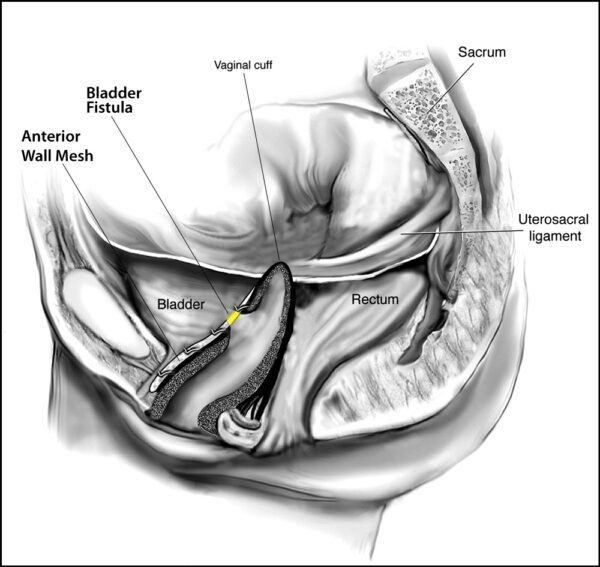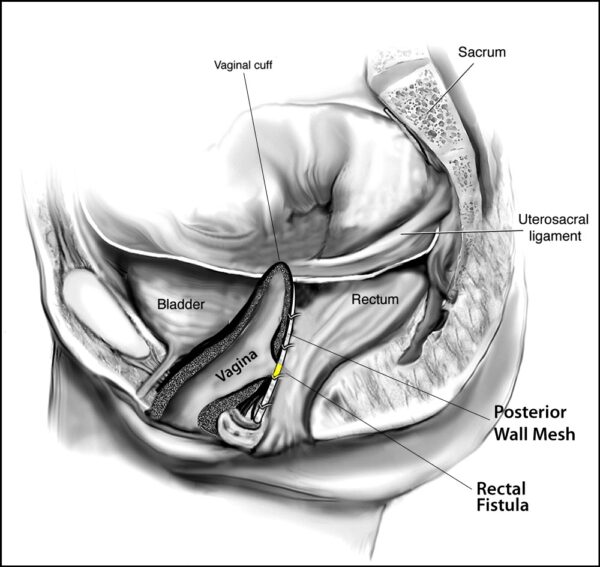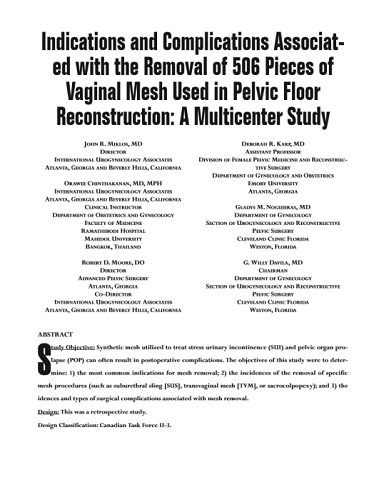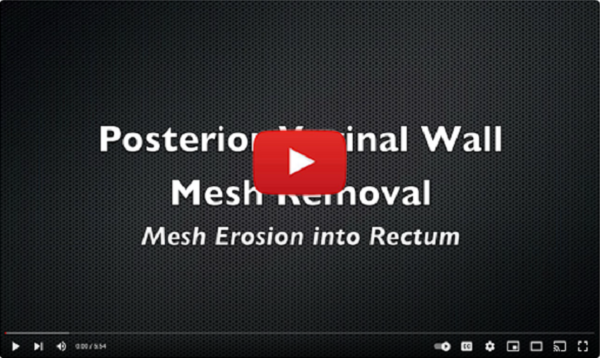WHAT ARE THE SIGNS AND SYMPTOMS OF TRANSVAGINAL MESH PROBLEMS?
Transvaginal mesh is a term which usually means that a piece of mesh was placed through the vagina and under the vaginal skin to support a falling structure like the bladder, rectum, vaginal vault, or the uterus. It is true that the TVT, TOT and single incision slings are transvaginal mesh procedures, but they are used to support the urethra to treat stress urine incontinence. When surgeons speak and use the words “transvaginal mesh” they are usually referring to mesh for prolapse of the bladder, rectum, vaginal vault or the uterus and when they speak of transvaginal mesh for the urethra, they will usually use the term “sling”.
A failed transvaginal mesh is a mesh which no longer supports the herniated or fallen bladder, rectum, intestine, uterus, and/or vaginal vault. Thus, the patient returns with vaginal prolapse in the area where the mesh is no longer supportive. However, it is possible that the support is adequate, but the patient suffers from a complication of the mesh. Complications include:
Chronic Pain– is one of the most common complications of transvaginal mesh surgery. This can be caused by nerve damage, mesh erosion into neighboring organs such as: bladder, urethra, rectum, small or large bowel or most commonly extrusion of the mesh through the vaginal skin. Pain can be also be attributed to excessive scar tissue which can pull on the nerve laden muscle and fascial layer.
Painful Sex – mesh can cause painful intercourse for the patient and / or her partner. Again, the scar tissue can cause pain and pain often results in difficulty enjoying intimacy and this can result in the inability to orgasm. Painful sex can also be due to complication of mesh exposure or mesh extrusion. (see descriptions below)
Groin Pain (aka inguinal pain) – patients will often have pain in the groin of one or both legs. Te groin is defined as the crease in the area between your inner thigh and the vulva is also known as the inguinal area. Mesh pain can also be referred to the inner or medial thigh from the pubic area down to the knee.
Pelvic or Lower abdominal pain – when patients suffer from pain in the lower abdomen or pelvis, then the mesh should be removed from the vagina as well as from the pelvis and lower abdomen. The vaginal portion of the mesh can be cut and removed from the vagina, but the arms of the mesh need to be removed using an abdominal incision (either via laparoscopy or laparotomy
Infection – which may result in tissue or organ wall infection which can manifest as a symptom of pain, fever, discharge.
Vaginal bleeding – is usually due to exposed mesh which is rubbing and irritating the vaginal skin.
Vaginal discharge – can be due to continued irritation of the mesh to the vaginal skin. Vaginal discharge can be found in patients who have mesh exposure or mesh extrusion, these scenarios may also be complicated with an infection or a sinus tract.
Mesh exposure – transvaginal mesh can become exposed, and this means one can actually see the mesh coming through the vaginal skin, but does not protrude above the level of the skin. The exposure may can cause pain, vaginal bleeding and/or discharge and painful intercourse for the patient. It is possible the patient’s partner will suffer from painful intercourse also.
Mesh erosion – is like mesh exposure, however, instead of the mesh migrating or being seen through the vaginal skin side, the mesh can migrate through the neighboring hollow organ such as the urethra, bladder, or rectum. Patients will often present with: pain, bleeding, infection, painful intercourse, blood in the urine or in the feces and/or pain during urination or defecation. Mesh erosion inside the bladder or rectum canl cause a fistula which results in urination and defecation from vagina. (Figure 1 and 2)
Urinary problems – may include complete urine retention, the inability to empty one’s bladder, urgency, frequency, overactive bladder, recurrent urinary tract infections or urinary incontinence. The mesh can cause urinary problems, such as urinary incontinence, urinary retention, and urinary tract infections.
If you are experiencing any of these signs or symptoms after undergoing transvaginal mesh surgery, it is important to consult with an experienced mesh removal surgeon or healthcare provider for proper evaluation and treatment. All too often patients are having mesh failures inappropriately treated or even inadequately evaluated. Failure to remove the mesh appropriately can lead to further complications and worsening conditions as well as making the remainder of the mesh even more difficult to find and remove during future surgeries.

Figure 1: Anterior Mesh -Fistula

WHY CHOOSE MIKLOS & MOORE UROGYNECOLOGY TO SOLVE YOUR TRANSVAGINAL MESH PROBLEMS?
Dr. Miklos is a highly experienced and skilled surgeon who specializes in the treatment of mesh complications. He has removed more than 1,000 pieces of mesh since 1994. Few surgeons in the world can make this claim. Dr. Miklos has a patient-centered approach to care and listens to the patient’s point of view concerning her signs and symptoms. Often the patient’s complaints and concerns are not supported by the scinetfic literature. Dr. Miklos will still listen and share his thoughts about her symptoms. He takes the time to thoroughly evaluate each patient’s unique situation and develop a personalized treatment plan and make recommendations but allows each patient to make the final decision as to the surgery and technique. He truly believes that he makes the patient an informed consumer so she can ultimately make the right decision to minimize or stop the patient’s pain and suffering. Overall, choosing Dr. Miklos for your mesh complication surgery can provide you with the expert care and support you need to achieve the best possible outcome. Dr Miklos has:
EXPERIENCE -First and foremost at Miklos & Moore Urogynecology the doctors listen. They have been removing mesh since 1998 and have seen, treated, or removed just about every type of transvaginal mesh and its associated complications. They have removed more than 1000 pieces of mesh with minimal complications and superior success. (Figure 3)
EXPERTISE – Miklos & Moore Urogynecology has treated patients from all over the world for mesh complications. They have produced award-winning videos which have gotten them international acclaim for their mesh-removing technique. Dr. Miklos has taught post-graduate courses for mesh removal at conferences in the USA, Australia, Europe and Africa.
KNOWLEDGE – The surgeons at Miklos and Moore Urogynecology are Rule 26 medical legal experts who understand the law and malpractice cases facing patients today. They are also leaders in the world on mesh complications as they have written some of the largest mesh complication papers found in the worldwide literature.
RESULTS – Miklos & Moore Urogynecology have addressed and removed some of the most difficult transvaginal mesh devices made and inserted in the human body. Though no one can guarantee the success rate for fixing the patient’s symptoms, Dr. Miklos can usually remove >95% of the mesh load > 90% of the time. Dr. Miklos can remove the complete or total implant most of the time if it is indicated.
Here at Miklos & Moore Urogynecology, we have removed 100’s of transvaginal mesh devices. When removing these devices, it is usually important to remove the total mesh, especially in patients suffering from chronic pain specific to the pathway of the mesh. Dr. Miklos has also removed the total transvaginal mesh from the bladder and rectum. (Video 1)
RECOVERY TIME AFTER FAILED MESH REMOVAL SURGERY?
The recovery time after mesh complication surgery is directly dependent upon the patient’s complication, its severity, as well as the surgical approach utilized during mesh placement and removal. This removal may only require a trans vaginal surgical approach or may require other concurrent approaches, including: laparoscopic, trans inguinal or trans gluteal.
If a patient only requires a vaginal incision to remove the transvaginal mesh or sling most likely the patient will spend one night in the hospital to recover and subsequently be released the next day. The patient is instructed to refrain from sex and heavy lifting or straining for 6 weeks. If the patient is having mesh removed through the abdomen, the recovery is also 6 weeks, however, if the patient requires concurrent surgery to fix potential vaginal prolapse or stress urine incontinence, the patient requires 12 weeks of pelvic rest before resuming normal activities.



